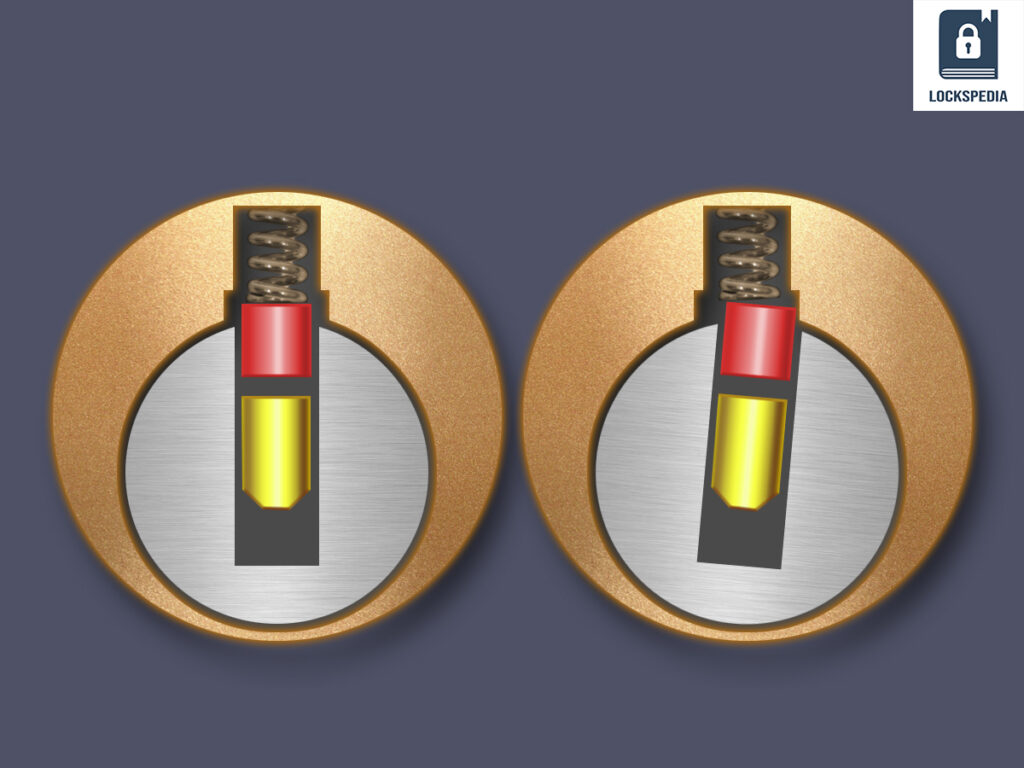If you want to learn single pin picking, you will have to understand a principle called the binding order. This fundamental principle is vital to our understanding of how to manipulate a pin tumbler lock, the most common type of lock used worldwide.
When we apply a rotational torque to a lock (through tension wrench or some substitute), the plug rotates a bit and then get stuck. This is caused by a pin which is trapped (binded) between the plug and the lock housing.
Until and unless, this binded pin is lifted to the sheer line, the plug will not rotate further. Once this is lifted to the sheer line (set), another pin will get trapped (binded) between the plug and the housing and so on.
There is a specific order in which these pins are trapped and need to be picked. This order is known as the binding order principle in lock picking.

In this article, we will learn everything about the binding order including what it is, why it happens and how it helps us, the lock pickers, manipulate the pins.
What is Binding Order in Lock Picking?
In order to understand the binding order in detail, it is important to first know different parts of a pin tumbler lock and how they come altogether to create an effective locking mechanism.
- Plug: It is the part where you insert the key
- Pins & Springs: There are 2 types of pins: driver and key pins. Springs push the pin between the plug and the housing thereby creating the locking mechanism.
- Lock Housing: The cylinder that houses the plug, springs and the pins.
- Sheer Line: The gap between the housing and the plug. All the pins need to be set at the sheer line in order to freely rotate the plug.
- Key: The bitting on the key matches with the splits between the pins. The bitting align perfectly with the splits thereby pushing the pins to the sheer line and hence freeing the plug to rotate.
In single pin picking, we try to mimic the behavior of the key by setting individual pin to the sheer line.
However, when we apply tension to a plug, it rotates few millimeters and then stops. This happens because a pin gets trapped between the plug and the housing. This trapped pin, which is known as binded pin, stops the plug from rotating further.
Therefore, until and unless we set this binded pin to the sheer line, the plug will be obstructed. Once we set the pin using any lock pick tool at the sheer line, the plug rotate a bit more and the next pin gets trapped. This process goes on until the last pin is set.
Now, the order in which these pins are trapped between the plug and the housing is called the binding order in lock picking.
What Creates The Binding Order?
At this point, one question that comes naturally to mind is what causes this binding order or pins to get stuck?
The phenomenon of binding order arises from minute manufacturing imperfections. Even high-quality locks have slight variations in the alignment of the pin chambers within the plug. When tension is applied, these inconsistencies cause one pin to bind before the others, indicating the pin we need to set first.
Let’s delve into manufacturing defect aspect a bit more.
In an ideal scenario, all the holes in pin chamber should be perfectly aligned as shown in the image below –

However, since locks are not manufactured with high precision, few imperfections remain in the plug. Below is an illustration of the same.

It is due to these imperfections that one pin gets trapped in the gap between the plug and the housing before others which blocks the free rotation of the plug.
So essentially the entire security of your house hinges on one trapped pin!
In single pin picking, we identify this binded pin and then set it to the sheer line. Once this is done, the plug rotate a bit more and another pin gets trapped. And the process goes on till the last pin is set at the sheet line.
Let’s now learn how to identify the binded pin.
How to Identify the Binded Pin?
To identify which pin is binding, we apply light rotational tension to the plug with a tension wrench and probe each pin with a pick. Binding pins will feel stiffer and resist movement, whereas non-binding pins will move more freely.
Though there is no specific pattern to which pin will bind first but in my experience if you are using BOK tensioning tool, it is better to start from the last pin. Feel each pin to find any resistance and then gradually move forward.
On the other hand, if you are using a top of the keyway tension tool, start from the front and then move backward.
Recognizing the subtle differences in how each pin feels is the key to determining the binding order and successfully setting each pin.
Our ability to discern which pin is binding and to correctly set it before moving on to the next is what often separates successful lock picking from mere trial and error.
Frequently Asked Questions
What is the importance of binding order when picking a lock?
The importance of binding order lies in its nature to reveal the sequence in which the pins within the lock must be set. When we understand the binding order, we can methodically pick each pin without randomly guessing which pin to set next.
